How To Save Your Home After A Flood With Cleaning And Restoration
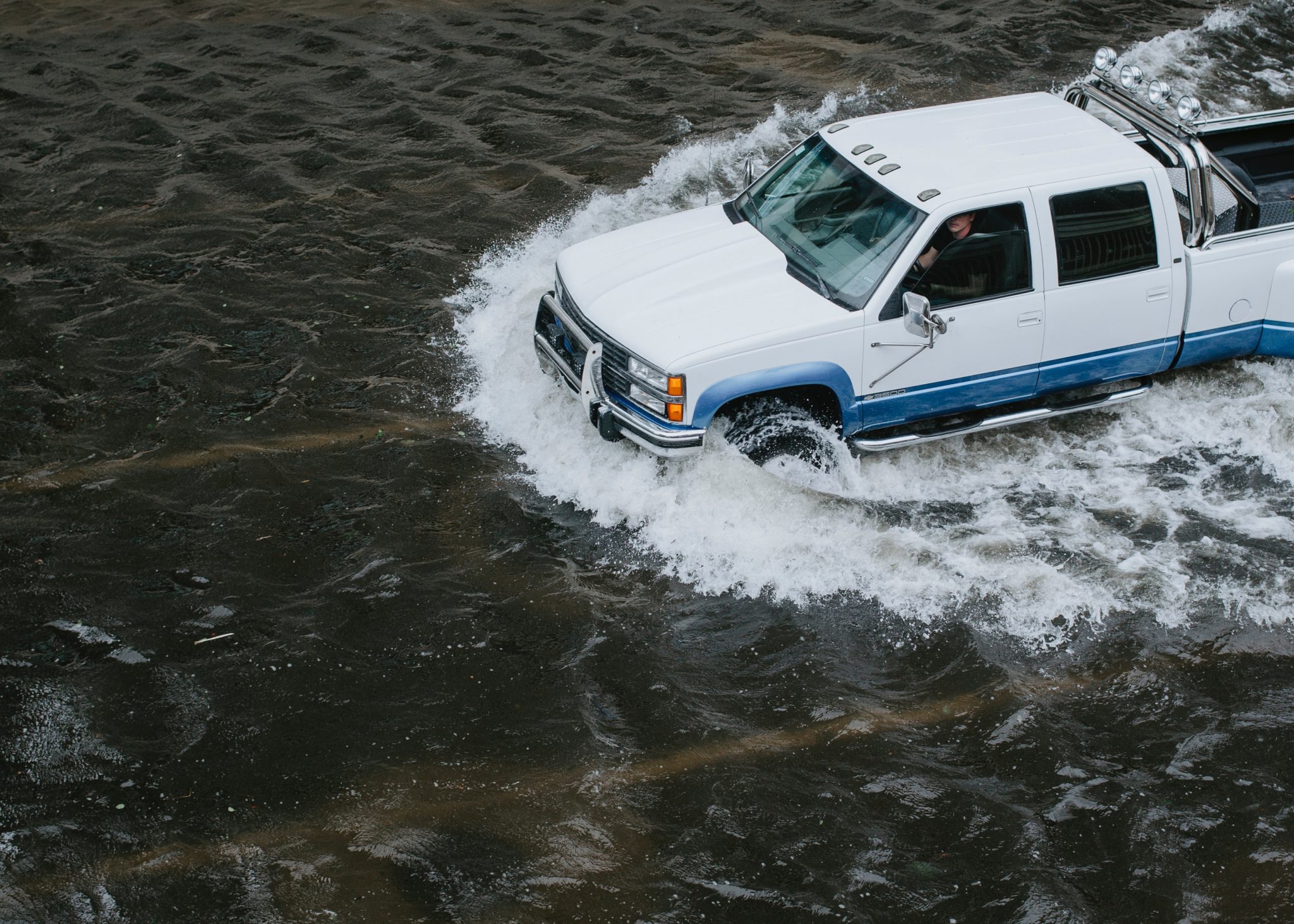
Cleaning up after your home has been flooded can seem like an impossible task. As well as the damage to your property and loss of belongings, the sheer devastation a flood leaves behind takes many homeowners by surprise. Floodwater is never just water—debris, mud, sewage, animal corpses and more all wash into your home, making cleaning up after a flood a complex and time-consuming task. However, it isn’t impossible, and you will get your home back to a livable condition again. By following our general post-flood cleaning instructions, as well as specific advice about your property from experts who inspect your home, you can start to recover from a flood and move on with your life.
Before a flood
If you get any advanced warning, use it wisely. Flooding is a catastrophic disaster and you should always put your safety first. Make sure to obey evacuation orders and never try to navigate floodwater. People can lose footing and vehicles be swept away in only a few inches of fast-moving water.
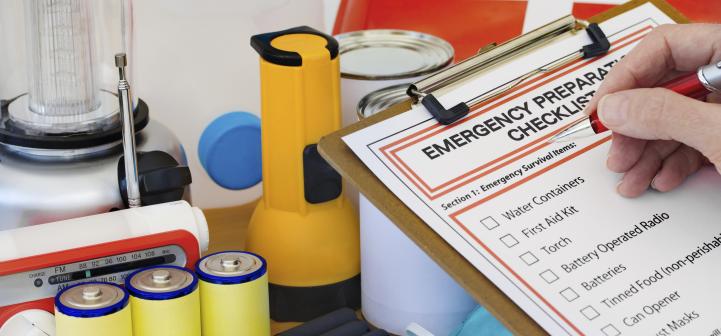
Before leaving your home, if you have to the time do so, make the post-flood cleanup easier by moving any valuable belongings to an upper floor. Assume that everything on the first floor will be lost to a height of approximately four feet. That means flooring, furniture, the contents of cupboards, wall coverings and more. If it’s touching the floor or is attached to the walls below the 4ft line, it will be destroyed.
Once you’ve moved anything you can that you want to save, take photographs. These will be incredibly useful if you do get flooded and have to make an insurance claim for the damage, as they will show your adjuster exactly what was in your house before the flood. Back up your photos to the cloud—most smartphones come with a basic cloud storage plan included—so even if your electronics are damaged you still have copies.
Returning to your home — safety and damage assessment
The first task after a flood has damaged your home is to assess the damage. If you’re lucky and the flooding was only minor you could carry out the repairs yourself. If the flood damage was extensive, covering the ground floor to the height of several feet, you will want to get your homeowners insurance involved if possible. In either case, it can take a while for professionals to get on site so you’ll want to start the cleanup as quickly as possible.
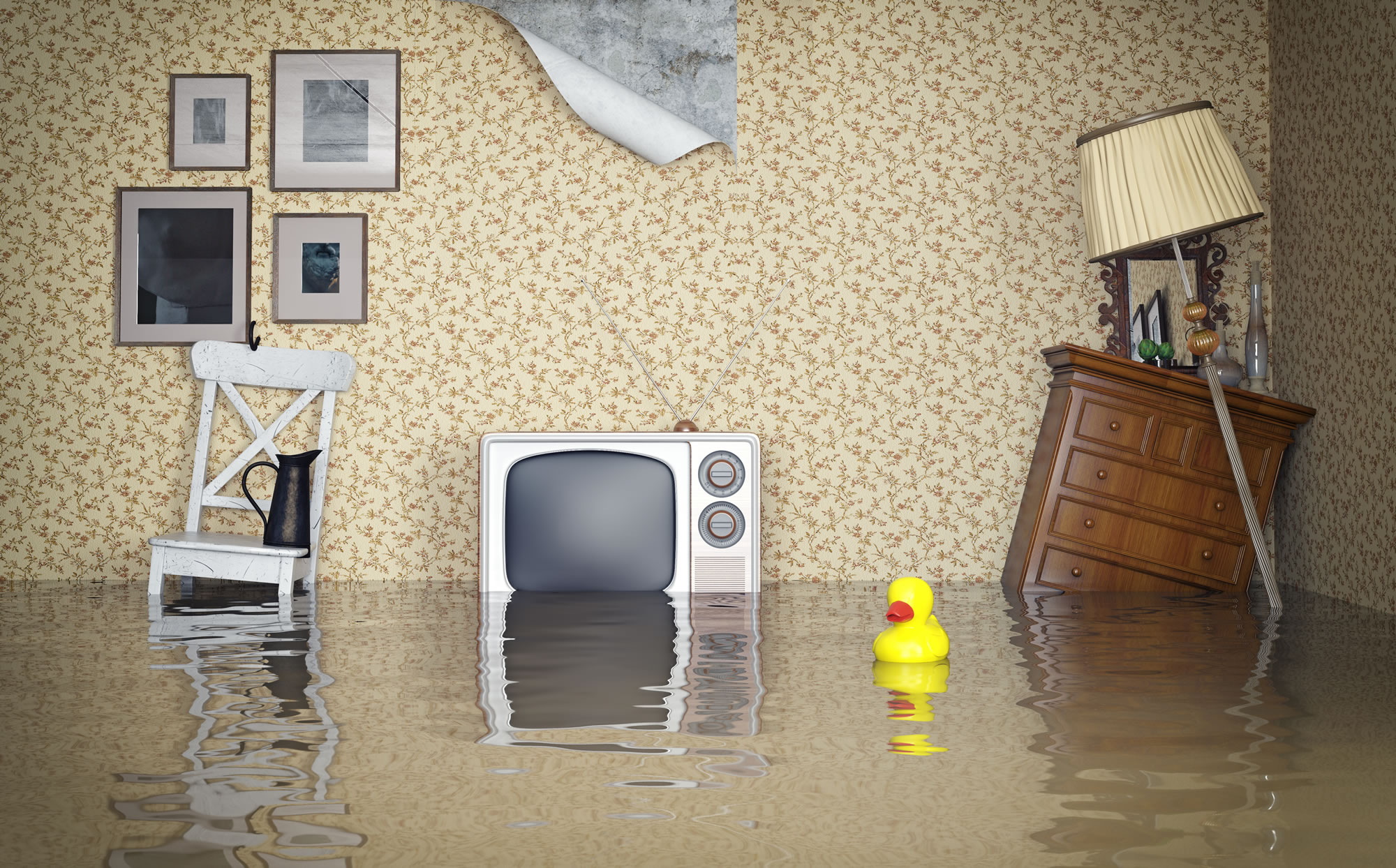
A couple of tips before work begins: flush the toilets to check there aren’t any blockages in the line, and don’t assume your tap water is drinkable until the water company confirms it’s safe. Stick with bottled water until you’re sure.
Take photographs of the damage and repairs at every stage. This will help you in the event you need to make an insurance claim, and even if you aren’t insured or don’t think a claim is necessary, seeing where the damage was in the immediate aftermath can help you when cleaning up. You need to remove anything that was contaminated by floodwater, and photos are a great reference if you can’t remember exactly where the water level reached, or if something was affected or not.
Make sure your home is safe to enter before you begin cleaning. Use a torch inside when you first enter the property, and don’t touch the electrics except to turn off the power. Call a qualified electrician to inspect your wiring and appliances, and in the meantime use a generator for all your power needs. Remember to never, ever run a generator (or grill, camp stove, or similar) inside the house or in a confined space outdoors. The fumes can overpower you and become toxic in minutes.
The last step before you can begin cleaning is to clear any standing water. If your basement is flooded, be sure to drain it slowly. Pumping it too fast can create a vacuum in the space left behind that could damage the foundations or even cause them to collapse. Check subfloors and wall cavities for any trapped water as well, and move around debris in your yard if it’s holding water. Standing water is a breeding ground for mosquitos and bacteria, neither of which are welcome.
Removing debris and damaged property
Before you can clean your home, you have to remove anything that has been contaminated. Others will be doing the same thing, so check with your county, city, or other authorities if they’re offering assistance for cleanup. If not, speak with your neighbors about splitting the cost of a large dumpster. You’ll want to arrange this as quickly as possible, because many waste management companies will be stretched thin trying to meet all the demand after a flood.
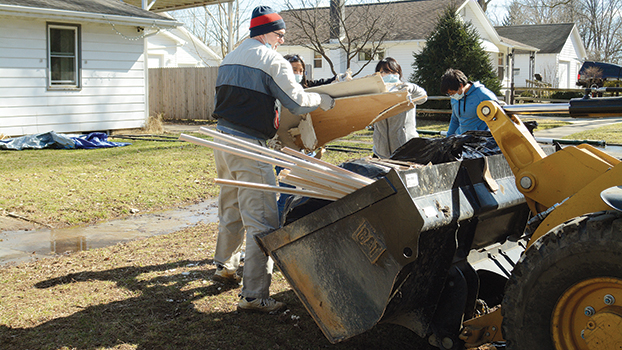
If you can’t get a dumpster, or don’t have anywhere on your property to store one, consider large capacity bags such as Bagster instead. They take up less space than a traditional dumpster and are usually cheaper, although collection prices vary by location. Whatever method you use, try not to leave any trash piled up, as it can attract pests and make cleaning harder.
Once you’ve got your dumpster in place, start tearing out everything the water touched. You need to wear protective gear when you do this, because the debris, mud, and residue from floodwater can be contaminated with bacteria and pathogens that will make you very sick.
The CDC recommends you wear the following safety gear when cleaning after a flood:
- Electrically insulated, watertight boots with steel shank, toe, and insole.
- Heavy, waterproof, cut-resistant work gloves.
- Goggles or safety glasses with side shields or full-face shields.
- Long-sleeved shirt and full pants, or coveralls.
- Hard hat and ear defenders if working in an environment where falling debris, electrical hazards, or loud noises are present.
- Respirators if cleaning mold or chemical/biological hazards.
You might think these precautions are excessive, but the last thing you want after suffering the devastation of a flooded home is to end up in the hospital as well.
Remove any debris the floodwater carried into your property, as well as furniture that got damaged. Don’t try to salvage anything. Chances are anything in the water is stained beyond repair, but even if you manage to dry out and clean your property, it can still harbor mold, spores, and bacteria that will continue to grow and could make you and your family very sick.
Once the first floor is empty, cut out the drywall and insulation to at least a foot above the high-water mark. Mold and bacteria cannot be properly removed from porous surfaces like drywall so you have to remove them, even if you think they look like they’ll dry out just fine. Take up all your flooring as well, including carpet, wood or laminate coverings, and floorboards. You need to expose the wall cavities and subfloor in order to properly dry, clean, and disinfect your house.
Drying and cleaning your property
Once everything has been stripped out, before you can start cleaning properly, you need to get the property dry. Use water pumps to get any last standing water out, then install dehumidifiers and fans to circulate the air and remove moisture. Be careful your dehumidifiers aren’t too strong, as materials such as timber will never be 100 percent moisture free, and drying them out too far will make them warp and crack. It’s usually a good idea to have the property dried and assessed by a professional to ensure it’s done correctly.
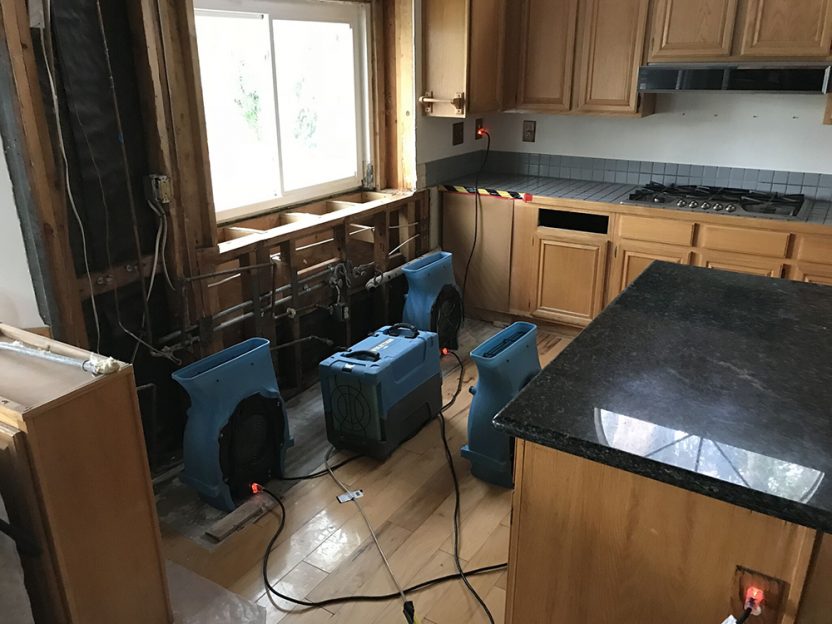
As well as getting everything dry, you need to disinfect all the places the water touched. It’s best to have an expert decide what decontaminant you should use in your house, as the recommendations may vary depending on the type and source of water, and the typical waterborne hazards in your area.
If you’re cleaning and decontaminating the house yourself, common chlorine bleach is a good all-purpose disinfectant that kills most bacteria. The only thing to keep in mind is because of its corrosive nature you can’t use it on metal or near air conditioning systems. A fungicide is also a good idea to prevent spores from growing in your home. You’ll need to use one that’s water vapor permeable (a perm rating of 20 is best, but go no lower than 5). If your treatment isn’t water vapor permeable it will prevent your property from fully drying out.
Make sure when you’re using chemical cleaners and treatments that you only apply one at a time and leave plenty of time in between each treatment so you don’t create any unwanted interactions. At minimum you should apply treatments several days apart. Always wear appropriate protective gear, including respirators and skin covering, when working with hazardous chemicals in confined spaces.
Cleaning and restoring your home
Cleaning your home after a flood is a difficult and exhausting process. You may have lost valuable or sentimental possessions, and seeing your house reduced to bricks and timbers can be traumatic. Flood restoration can take a long time, particularly if your home doesn’t respond well to drying equipment. However it will eventually get fixed, and as you rebuild you can make changes that will help you more quickly recover if your property floods again.
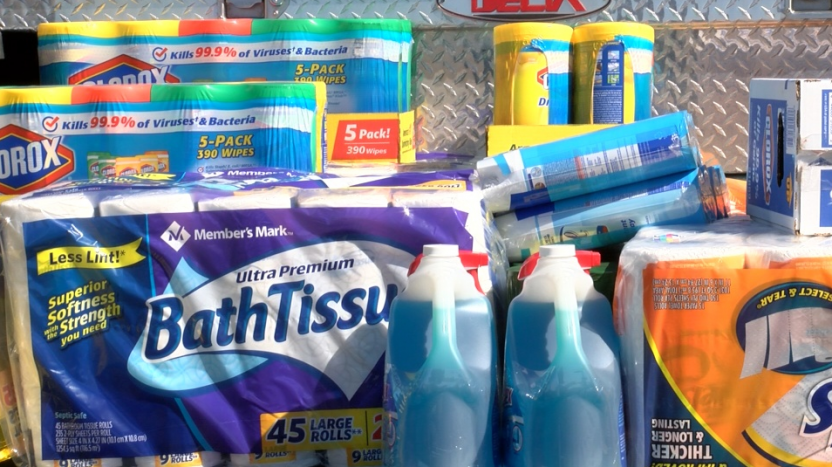
Take supplies with you when you visit your house to begin cleaning. The stores around your home will probably be sold out or overcrowded if the area has sustained extensive flooding, so it’s usually easier to buy things elsewhere. A basic list of supplies includes:
- Trash bags
- Disposable rags and microfiber cloths
- Bleach
- Dish soap
- White vinegar
- Rubber gloves
- Paper towels
- Mop and bucket
- Shovel
- Stiff-bristled broom
- Clean bottled water for cleaning and washing
- First aid supplies
- Antibacterial soap and hand sanitizer
- Bottled water for drinking
- Toilet paper
- Snacks and sandwiches
Repairing the damage to your walls and floors will create plenty of dust on the first floor of your home. To protect upper floors, use plastic sheeting to block off stairs and doorways, and keep interior doors closed.
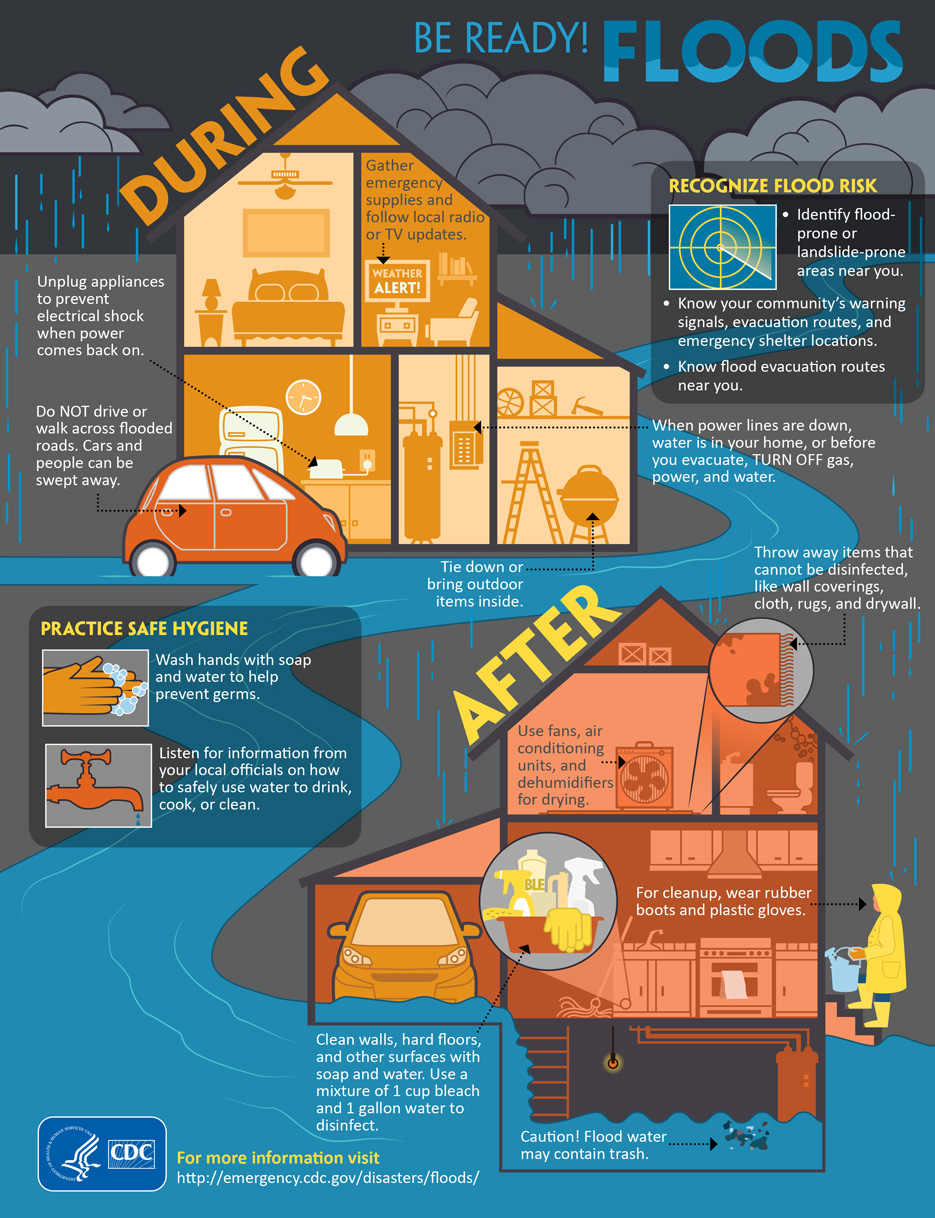
Don’t shut off any areas of your house completely. You will still need air to circulate to prevent damp and mold from taking hold, so open windows when possible or run fans in each upstairs room, regulate the temperature so it isn’t too hot or cold inside, and check on your contents frequently. If your post-flood cleanup is going to take a long time, look into storage options for your undamaged belongings to prevent them from becoming affected.
After a flood, you might find you have to do more cleaning than normal, especially in the dry parts of your house. Dust will settle over time, rooms will become musty, and the extra humidity from the drying floodwater means even the unaffected rooms need more intensive cleaning. Wash down walls and ceilings with an antibacterial and fungicidal solution and sweep and dust regularly to prevent accumulations.
Tips for cleaning different materials
Fabrics such as bedding, clothing, and curtains are best being removed from the home entirely, or stored in airtight plastic casings. Before wearing or using them again, wash them on the highest possible setting and either tumble dry or hang them in the sun to dry thoroughly in order to kill any pathogens that may be on them.
Paper products like books, magazines, and important documents should also be removed or kept in airtight containers. If important books or documents got wet, you can try to salvage them by placing them in a freezer for a few days to kill bacteria, then air-drying them with the pages fanned.
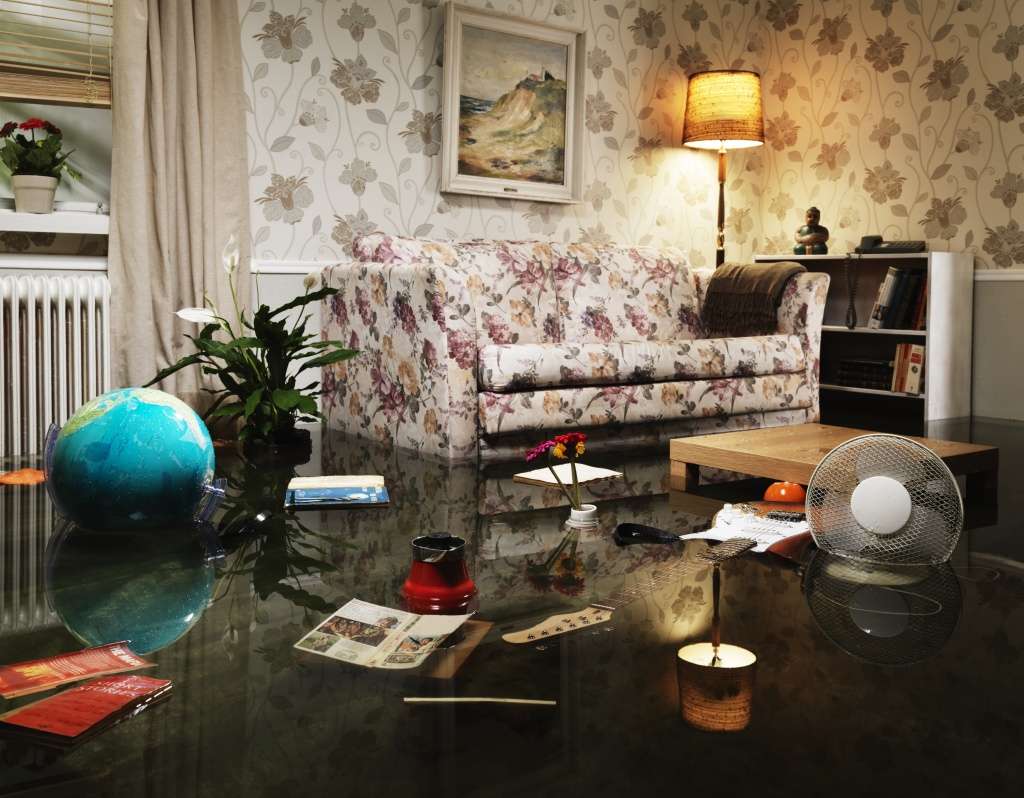
Wooden furniture can swell up or warp. This is often the result of the higher level of humidity in the home as the floodwater dries. As the humidity lowers, furniture may well return to its original shape. This is only true of real wood: laminated products are usually beyond repair if they swell or “blow” due to water damage or high humidity. If you have furniture such as dressers and wardrobes you want to protect, open doors and drawers and remove back panels when possible to allow as much air to circulate around and through them as you can. If a door gets jammed or a drawer is stuck, let the swelling go down without trying to force it open.
Take all electronics that weren’t directly affected by floodwater out of your house as soon as possible. Not only is this a good security measure but leaving them in a damp, uninhabited home for a long period will damage most devices beyond repair.
Your major appliances, such as fridges, freezers, cookers, and dishwashers, need to be inspected by an electrician before you can decide if they’re worth salvaging. If the water wasn’t very high and damage was minimal, a good cleaning will get them back in working order. First discard any food contents, then wipe down each appliance with bleach and allow to air dry. Don’t rinse the bleach off—you want it to kill any bacteria that could be inside. Don’t forget vents and drains as well. Run washing machines and dishwashers on the hottest cycle using bleach and your usual detergent or soap to get all parts sparkling clean again.
Getting back to normal
Recovering from a flood is a long and grueling process, but it is possible, and in the aftermath you can make decisions about your property that will help if flooding ever happens again. By taking prompt action and using the right precautions to protect against mold, bacteria, and other hazards, you can also save your home and family from even greater harm in the future.
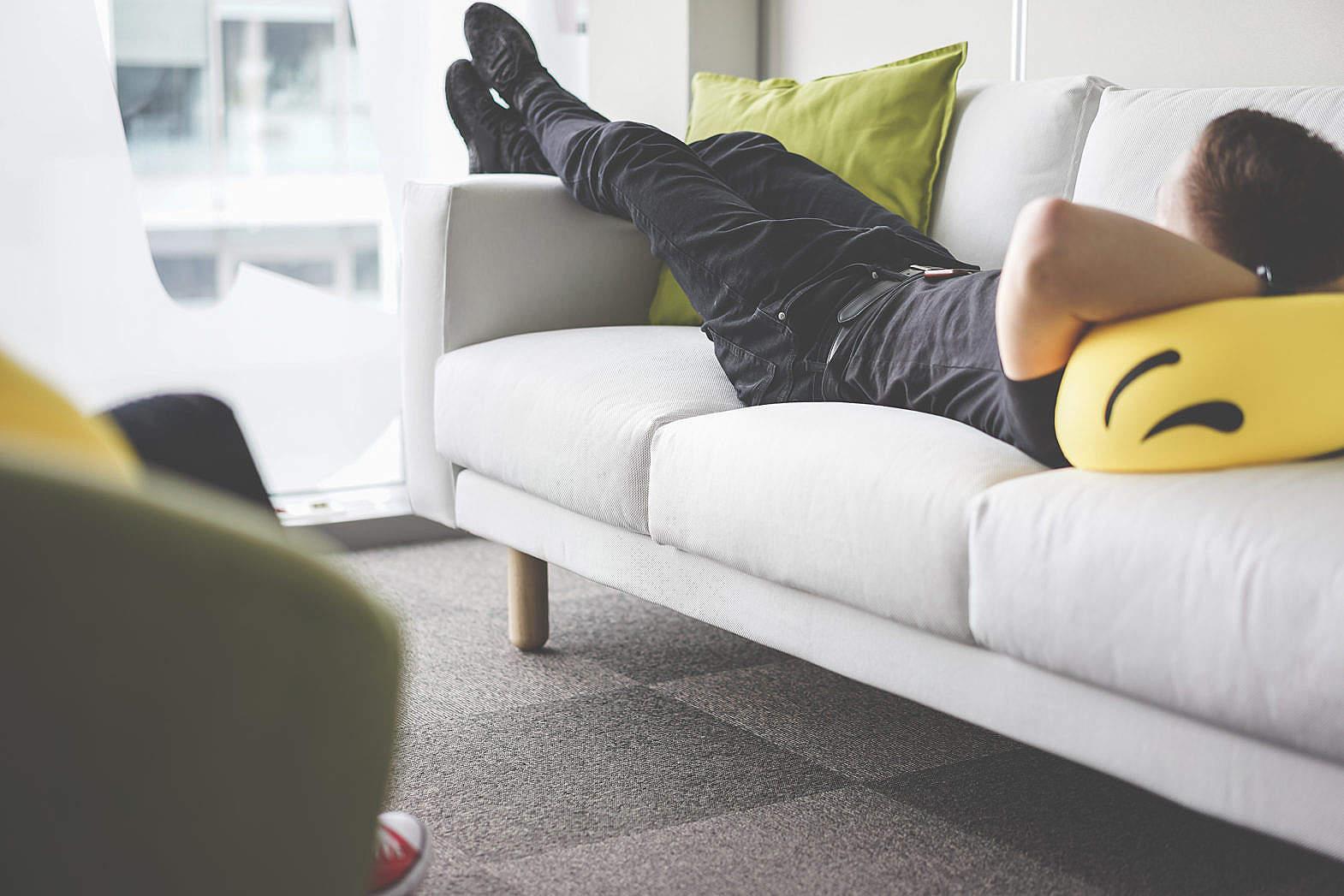
If you live in a flood plain, having flood insurance will give you the most protection in the event the unthinkable happens. However knowing how to clean your property, what hazards to be aware of, and where to start restoring your home, will help you take the initiative and increase your chances of rebuilding quickly after a major flood.